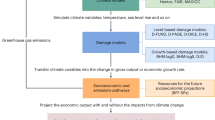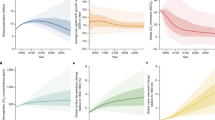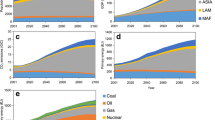Abstract
Mitigating the effects of human-induced climate change requires the reduction of greenhouse gases. Policymakers must balance the need for mitigation with the need to sustain and develop the economy. To make informed decisions regarding mitigation strategies, policymakers rely on estimates of the social cost of carbon (SCC), which represents the marginal damage from increased emissions; the SCC must be greater than the marginal abatement cost for mitigation to be economically desirable. To determine the SCC, damage functions translate projections of carbon and temperature into economic losses. We examine the impact that four damage functions commonly employed in the literature have on the SCC. Rather than using an economic growth model, we convert the CO2 pathways from the Representative Concentration Pathways (RCPs) into temperature projections using a three-layer, energy balance model and subsequently estimate damages under each RCP using the damage functions. We estimate marginal damages for 2020–2100, finding significant variability in SCC estimates between damage functions. Despite the uncertainty in choosing a specific damage function, comparing the SCC estimates to estimates of marginal abatement costs from the Shared Socioeconomic Pathways (SSPs) indicates that reducing emissions beyond RCP6.0 is economically beneficial under all scenarios. Reducing emissions beyond RCP4.5 is also likely to be economically desirable under certain damage functions and SSP scenarios. However, future work must resolve the uncertainty surrounding the form of damage function and the SSP estimates of marginal abatement costs to better estimate the economic impacts of climate change and the benefits of mitigating it.













Similar content being viewed by others
Notes
DICE and FUND are both open-source models, while PAGE is not.
RCP data are from https://tntcat.iiasa.ac.at/RcpDb/dsd?Action=htmlpage&page=welcome [accessed May 17, 2021].
The authors thank F. vander Ploeg for drawing our attention to the various damage functions used in the literature.
The RCP scenarios were used as inputs into climate models for the fifth Coupled Model Intercomparison Project (CMIP5), which then formed the basis of AR5.
An example would be cloud formation. A warmer atmosphere holds more water vapor, some of which turns into clouds. Cloud formation can exacerbate the initial warming by reflecting and re-emitting outgoing radiation back to the Earth’s surface, but it can also create an albedo effect by reflecting incoming solar radiation back to space, suppressing the initial warming. The overall effect depends on the cloud’s density, altitude, and the time of day.
Mass of the atmosphere equals 5.148 × 1018 kg. Assuming a CO2 concentration of 415 ppm, the mass of carbon in the atmosphere as a percent = 0.0415% × 44.0087 g ∙ CO2 ∙ mole–1 / 28.971 g ∙ mole–1 = 0.06304% CO2 by mass; multiply by the mass of the atmosphere to get the figure in the text.
SSP data are from https://tntcat.iiasa.ac.at/SspDb/dsd?Action=htmlpage&page=10. We use the SSP marker scenarios.
The climate-damage relationship is convex for most damage functions; for the Burke damage function, damages are linear but exhibiting concavity at higher temperatures.
References
Ackerman F, Stanton E (2012) Climate risks and carbon prices: revising the social cost of carbon. Econ Open-Access Open-Assess E-J 6:10
Arias PA, Bellouin N, Coppola E, Jones RG, Krinner G, Marotzke J, Naik V et al. (2021) Technical summary. In: Masson-Delmotte V, Zhai P, Pirani A, Connors SL, Péan C, Berger S, Caud N, et al., (eds) Climate change 2021: The physical science basis contribution of Working Group I to the Sixth Assessment Report of the Intergovernmental Panel on Climate Change. Cambridge University Press, Cambridge, in press
Auffhammer M (2018) Quantifying economic damages from climate change. J Econ Perspect 32:33–52
Burke M, Hsiang SM, Miguel E (2015) Global non-linear effect of temperature on economic production. Nat 527:235–39
Charney JG (1979) Carbon dioxide and climate: A scientific assessment report of an ad hoc study group on carbon dioxide and climate. National Academy of Sciences, Washington, https://www.bnl.gov/envsci/schwartz/charney_report1979.pdf
Connolly R, Connolly M, Carter RM, Soon W (2020) How much human-caused global warming should we expect with Business-As-Usual (BAU) climate policies? A semi-empirical assessment. Energies 13:1365. 103390/en13061365
Curry J (2021) IPCC AR6: Breaking the hegemony of global climate models, climate etc. blog 6 October. https://judithcurry.com/2021/10/06/ipcc-ar6-breaking-the-hegemony-of-global-climate-models/#more-27876. Accessed 10 Oct 2021
Dellink R, Chateau J, Lanzi E, Magné B (2017) Long-term economic growth projections in the shared socioeconomic pathways. Glob Environ Change 42:200–214
Gettelman A, Hannay C, Bacmeister JT, Neale B, Pendergrass AG, Danabasoglu G, Lamarque J-F et al. (2019) High climate sensitivity in the Community earth system model version 2 (Cesm2). Geophys Res Lett 46:8329–37
Golosov M, Hassler J, Krusell P, Tsyvinski A (2014) Optimal taxes on fossil fuel in general equilibrium. Econometrica 82:41–88
Hausfather Z, Peters GP (2020) Emissions: The ‘Business as Usual’ scenario is misleading. Nat 577:618–620
Hope C (2013) Critical issues for the calculation of the social cost of CO2: Why the estimates from page 09 are higher than those from page 2002. Clim Change 117:531–43
IPCC (2013) Climate change 2013: The physical science basis contribution of Working Group I to the Fifth Assessment Report of the Intergovernmental Panel on Climate Change. Stocker TF, Qin D, Plattner G-K, Tignor M, Allen SK, Boschung J, Nauels A et al. (eds) Cambridge University Press, Cambridge
IPCC (2021) Summary for policymakers. In: Masson-Delmotte V, Zhai P, Pirani A, Connors SL, Péan C, Berger S, Caud N, et al., (eds) Climate change 2021: The Physical Science Basis Contribution of Working Group I to the Sixth Assessment Report of the Intergovernmental Panel on Climate Change. Cambridge University Press, Cambridge, in press
Koonin SE (2021) Unsettled what climate science tells us, what it doesn’t, and why it matters. BenBella Books, Dallas
Lewis N, Curry J (2018) The impact of recent forcing and ocean heat uptake data on estimates of climate sensitivity. J Clim 31:6051–71
National Academies of Sciences, Engineering and Medicine (2017) Valuing climate damages: Updating estimation of the social cost of carbon dioxide. The National Academies Press, Washington, 1017226/24651
Newell RG, Prest BC, Sexton SE (2021) The GDP-Temperature relationship: implications for climate change damages. J Environ Econ Manag 108:102445. https://doi.org/10.1016/j.jeem.2021.102445
Nordhaus WD (1991) To slow or not to slow: the economics of the greenhouse effect. Econ J 101:920–37
Nordhaus WD (2008) A question of balance: weighing the options on global warming policies. Yale University Press, New Haven
Nordhaus WD (2014) Estimates of the social cost of carbon: Concepts and results from the DICE-2013r model and alternative approaches. J Assoc Environ Resour Econ 1:273–312
Nordhaus WD (2017) Revisiting the social cost of carbon. Proc Natl Acad Sci 114:1518–23
Nordhaus WD (2018) Evolution of modeling of the economics of global warming: Changes in the DICE model, 1992–2017. Clim Change 148:623–40
Pindyck RS (2013) Climate change policy: what do the models tell us? J Econ Lit 51:860–72
Pretis F (2020) Econometric modelling of climate systems: the equivalence of energy balance models and cointegrated vector autoregressions. J Econ 214:256–73
Riahi K, van Vuuren DP, Kriegler E, Edmonds J, O’Neill BC, Fujimori S, Bauer N et al. (2017) The shared socioeconomic pathways and their energy, land use, and greenhouse gas emissions implications: an overview. Glob Environ Change 42:153–68
Sherwood SC, Huber M (2010) An adaptability limit to climate change due to heat stress. Proc Natl Acad Sci 107:9552–55
Seneviratne SI, Nicholls N, Easterling D, Goodess CM, Kanae S, Kossin J, Luo Y et al. (2012) Changes in climate extremes and their impacts on the natural physical environment. In: Field CB, Barros V, Stocker TF, Qin D, Dokken DJ, Ebi KL, Mastrandrea MD, et al., (eds) Managing the risks of extreme events and disasters to advance climate change adaptation. Cambridge University Press, Cambridge
Tol RSJ (2019a) Climate economics: Economic analysis of climate, climate change and climate policy. Edward Elgar Publishing, Cheltenham
Tol RSJ (2019b) A social cost of carbon for (almost) every country. Energy Econ 83:555–566
van Kooten GC, Eiswerth ME, Izett J, Russell AR (2021) Climate change and the social cost of carbon: DICE explained and expanded. REPA Working Paper #2021-01. http://web.uvic.ca/~repa/publications.htm
van Vuuren DP, Edmonds J, Kainuma M, Riahi K, Thomson A, Hibbard K, Hurtt GC et al. (2011) The representative concentration pathways: an overview. Clim Change 109:5–31
Warren R, Hope C, Gernaat DEHJ, van Vuuren DP, Jenkins K. Jenkins (2021) Global and Regional Aggregate Damages Associated with Global Warming of 1.5 to 4 °C above Pre-industrial Levels. Climatic Change 168:24
Weitzman ML (2010) What is the “damages function” for global warming—and what difference might it make? Clim Change Econ 1:57–69
Acknowledgements
The authors acknowledge funding from Canada’s Social Sciences and Humanities Research Council (SSHRC grant #435-2020-0034). We are grateful for the feedback of two anonymous reviewers.
Author information
Authors and Affiliations
Contributions
ARR: contributed to writing (original draft preparation), formal analysis, and data curation. GCvK: conceptualized research, supervision, funding acquisition, and contributed to formal analysis and writing (review and editing). JGI and MEE: contributed to data curation, formal analysis and writing (review and editing).
Corresponding author
Ethics declarations
Conflict of interest
The authors declare no competing interests.
Additional information
Publisher’s note Springer Nature remains neutral with regard to jurisdictional claims in published maps and institutional affiliations.
Rights and permissions
About this article
Cite this article
Russell, A.R., van Kooten, G.C., Izett, J.G. et al. Damage Functions and the Social Cost of Carbon: Addressing Uncertainty in Estimating the Economic Consequences of Mitigating Climate Change. Environmental Management 69, 919–936 (2022). https://doi.org/10.1007/s00267-022-01608-9
Received:
Accepted:
Published:
Issue Date:
DOI: https://doi.org/10.1007/s00267-022-01608-9




